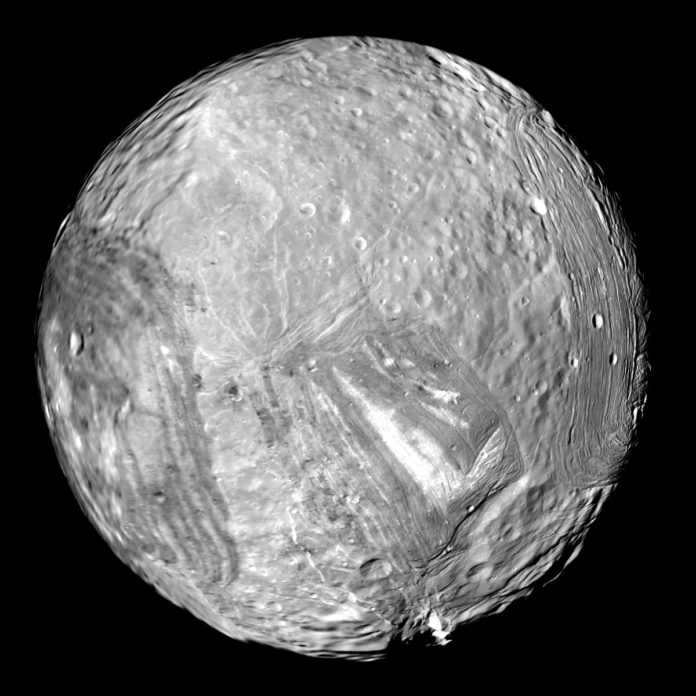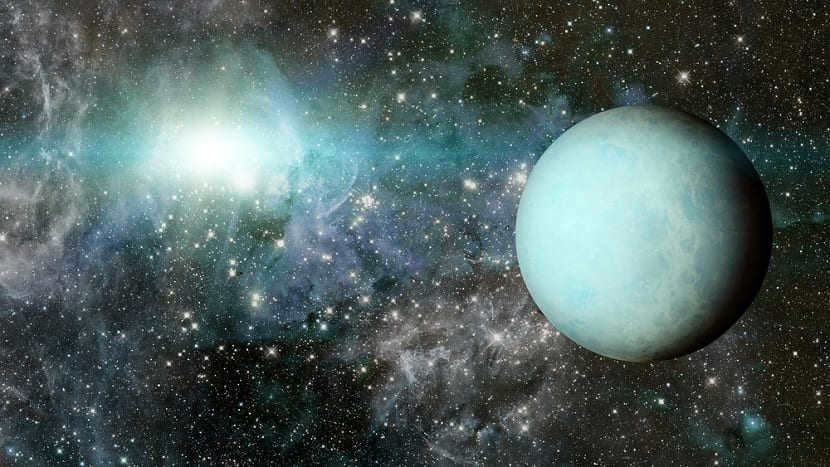
As we have discussed in previous articles, our solar system is comprised of 8 planets and the planetoid Pluto, which is no longer classified as a planet due to its size. We have already examined Mercury, Venus, Mars, Jupiter, and Saturn in detail, so now we can focus on Uranus. Known as the iconic blue sphere, this post will provide you with all the information you need to know about this fascinating planet.
Curious to learn more about Uranus? Keep reading to uncover all of its secrets.
Distinctive Features of Uranus
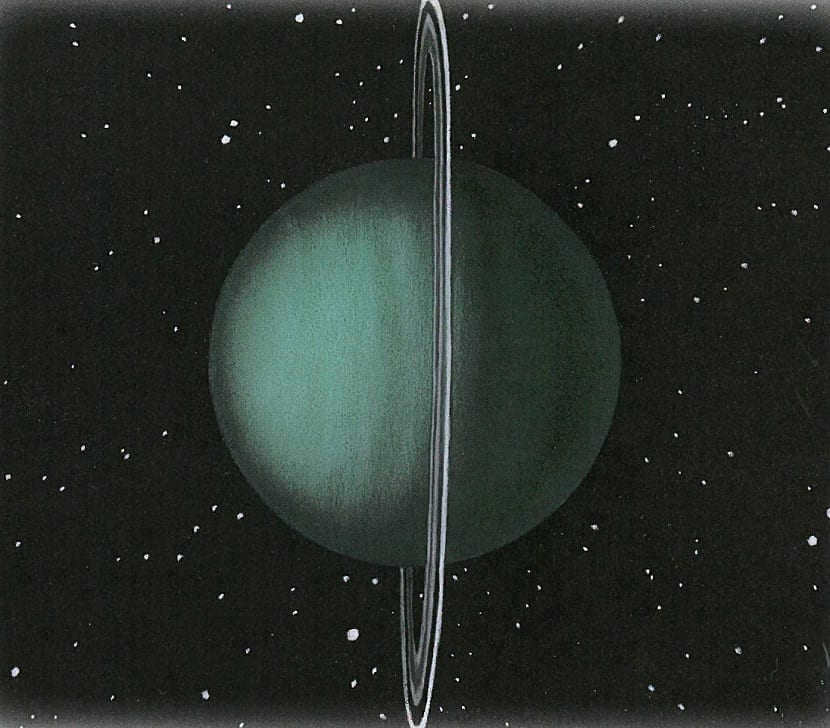
When it comes to its position in our solar system, Uranus is known as the seventh planet from the Sun. It is situated between Mercury, which is the closest planet to the Sun, and Neptune, which is the farthest. Notably, among the gas giants, Uranus ranks third in terms of size and mass.
With a diameter of 51,118.20 km, Uranus is located at a distance approximately 20 times greater than that of Earth from the Sun. This planet derived its name from Uranus, a Greek god. Unlike other planets characterized by a rocky or complex structure, Uranus possesses a relatively simple and homogeneous surface. The distinctive blue and green coloration of Uranus is not a result of sunlight angle, but rather the composition of its gases.
The individual responsible for the discovery of this celestial body was William Herschel, who made the groundbreaking observation on March 13th, 1781. During this period, numerous individuals were actively engaged in studying the vast expanse of the night sky, endeavoring to unravel the mysteries of the cosmos. To successfully uncover Uranus, Herschel ingeniously constructed his own telescope. Upon sighting a distinct greenish-blue speck amidst the celestial abyss, he initially reported it as a comet. However, further examination revealed that it was indeed a previously unknown planet.
Uranus holds the esteemed rank of being the sixth planet in the solar system, standing just behind Jupiter. Notably, its elliptical orbit spans a considerable distance, necessitating approximately 84 years to complete a full revolution around the sun – a stark contrast to the Earth’s significantly shorter orbital period. In essence, while our planet completes 84 orbits around the sun, Uranus has only managed a solitary revolution.
Writing
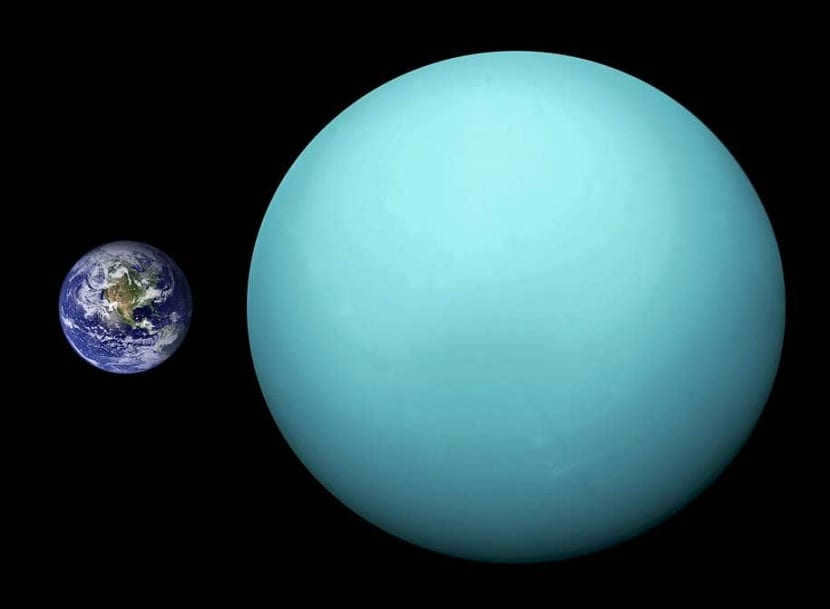

It is approximately four times the size of our planet, and its density is only 1.29 grams per cubic centimeter. Within its inner composition, there are various types of rocks and ice. The rocky core is quite abundant, and the most abundant gases in its atmosphere are hydrogen and helium. These two gases account for 15% of the planet’s total mass.
This is why it is known as a gas giant. The tilt of its rotational axis is almost 90 degrees in relation to its orbit. It is worth noting that our planet has a tilt of 23 degrees. Uranus also possesses a ring similar to Saturn, although not of the same size. The tilt of the axis also impacts the rings and their satellites.
Due to the tilt of its axis, Uranus experiences only two seasons per year. For a period of 42 years, one pole of the planet is illuminated by the sun, followed by another 42 years of illumination on the opposite pole. Being located so far from the sun, Uranus has an average temperature of approximately -100 degrees Celsius.
Unlike Saturn’s ring system, Uranus has a unique ring system composed of dark particles (for more information, see What is dark matter?). In the realm of science, many significant discoveries occur by chance, and the search for the best often leads to unexpected findings. These rings were accidentally discovered in 1985 during the Voyager 2 space probe’s mission to reach Neptune. As the probe passed by Uranus, it had the opportunity to observe the planet’s rings.
Thanks to state-of-the-art technology, scientists have determined that one of Uranus’ rings is blue while the other is red.
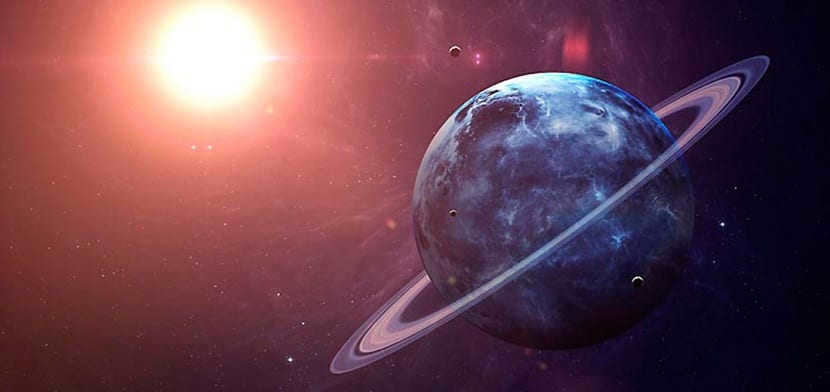
Typically, planets with rings are red, but discovering blue rings is incredibly fortunate. In terms of its atmosphere and composition, it consists of 85% hydrogen, 15% helium, and a small quantity of methane. This unique blend of gases gives it a mesmerizing greenish-blue hue.
Interestingly, this planet houses a liquid ocean, although it bears no resemblance to the oceans found on Earth. The planet’s atmosphere, composed of the aforementioned gases, condenses into a liquid state as it descends, eventually covering the entire icy surface with a mixture of water, ammonia, and methane gas. We mentioned that this ocean is unlike anything on Earth because it is primarily composed of water and ammonia. Consequently, it exhibits highly conductive properties and poses significant hazards.
Unlike Jupiter and Saturn, Uranus is primarily composed of ice rather than gases due to its significant distance from the Sun. As a result of these lower temperatures, scientists have classified Uranus as an ice giant. The scientific community has yet to determine the cause of Uranus’ tilted axis, but one theory suggests that it may have been the result of a collision with another protoplanet or a large rock during its formation.
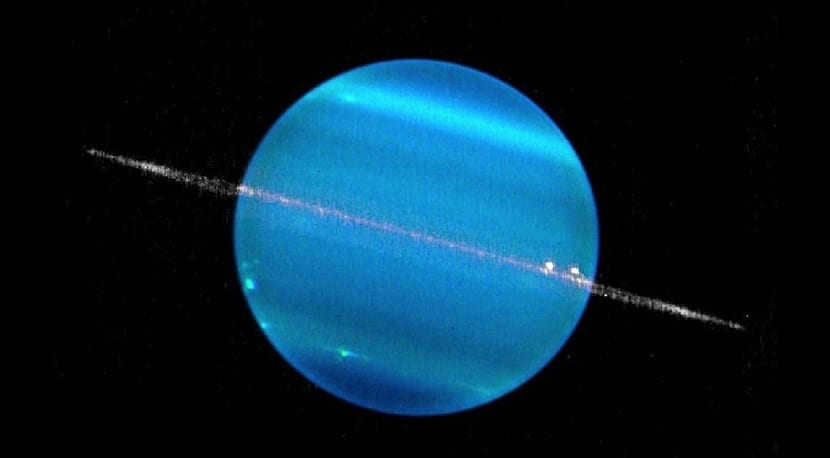
It possesses 27 satellites, some of which are more famous than others. These satellites do not have sufficient size to possess their own atmospheres. Voyager 2 probes have also discovered them and named them Titania and Oberon. Another satellite called Miranda is composed of water and dust ice and holds the record for having the highest cliff in the whole solar system, which is over 20 kilometers tall. It is ten times larger than the Grand Canyon on our planet.
As observed, Uranus is a planet that never fails to astonish us and still holds many secrets to be unraveled. With the advancement of technology, we may be able to uncover more and more about this fascinating planet.
The content of this article adheres to our editorial ethics principles. To report an error, click here.
Summary of the Full Article: Network Meteorology “astronomy” The Planet Uranus
Uranus, which is the seventh planet from the Sun and the third largest in terms of diameter and fourth largest in terms of mass, has an interesting characteristic. Despite being larger in diameter, Uranus is actually less massive than Neptune. It can sometimes be barely seen with the naked eye on a very clear night, but it is relatively easy to spot with binoculars if you know where to look.
It is located at an average distance of 19.1914 astronomical units (2.8 billion km) from the Sun, has an equatorial diameter of 25,559 km (4 times that of Earth), and a mass of 8.6813 x 10^25 kg (equivalent to 14.54 Earth masses). Its orbital period around the Sun is 84 Earth years. The average temperature on Uranus is approximately 60 Kelvin. It has 27 moons and is a satellite of the Sun.
Uranus, the ancient Greek god of the sky, is considered the earliest and most powerful deity, known as the father of Chronos (Saturn), Cyclops, and Titan (predecessors of the Olympic gods).
Discovery Background
The accidental discovery of Uranus, the first planet to be discovered in modern history, occurred on March 13, 1781, when W. Herschel observed the sky through a telescope. Initially, he mistook the planet for a comet. It was later revealed that the planet had been observed multiple times before, but it had been mistakenly identified as a regular star. The earliest record of this “star” dates back to 1690, when John Flamsteed cataloged it as 34th Taurus, one of the designated stars in constellations.
Uranus was explored by a single spacecraft, Voyager 2, which made a close flyby of the planet. On January 24, 1986, Voyager 2 passed within 81,500 km of Uranus. This mission resulted in the transmission of numerous images and scientific data about Uranus, including its satellites, rings, atmosphere, space, and the magnetic field surrounding the planet. Based on the data collected, it was determined that Uranus has a rotation period of 17 hours and 14 minutes. Additionally, Voyager 2 discovered an unusually large magnetosphere surrounding the planet.

Characteristics of Uranus’ rotational motion
Most planets have a nearly perpendicular axis of rotation relative to the ecliptic plane (the plane of the Sun’s apparent annual path on the celestial sphere), but Uranus has an axis that is almost parallel to this plane. The reason for Uranus’ “tilted” orbit remains unknown. However, there is a debate over which pole of Uranus is the north pole. These debates are not like arguing about a stick with two ends and two beginnings. The actual circumstances of this planet’s rotation carry significant implications for the theory of the entire solar system’s origin, as most hypotheses propose planets rotating in one direction. If Uranus formed while lying on its side, it would greatly contradict speculation about the origin of our planetary system. Nevertheless, it is increasingly believed that this planet’s orientation is the result of a collision with a large celestial body, such as a massive asteroid, during the early stages of Uranus’ formation.
Composition of substances, physical conditions, and structure
Uranus originated from original solid materials and various types of ices (the term “ice” in this context does not only refer to water ice). It consists of only 15% hydrogen, with almost no helium present (unlike Jupiter and Saturn, which are predominantly composed of hydrogen). Methane, acetylene, and other hydrocarbons are found in much larger quantities compared to Jupiter and Saturn. The winds in the mid-latitudes of Uranus cause clouds to move in the same directions as on Earth. These winds blow at speeds ranging from 40 to 160 meters per second, while on Earth, fast atmospheric currents move at around 50 meters per second.

The celestial body Uranus is comprised of three distinct components: a central rocky core, an intermediate layer of ice, and an outer atmosphere primarily composed of hydrogen and helium. The vibrant blue hue of Uranus arises from the methane present at the uppermost portion of its atmosphere, which absorbs red light. Although other cloud formations of varying colors may exist, they remain concealed from view due to the overlaying presence of methane. Notably, the atmosphere of Uranus is composed of approximately 83% hydrogen, 15% helium, and 2% methane.

Uranus’ ring system
Similar to other gas giants, Uranus possesses a ring system. The existence of rings around Uranus was officially confirmed on March 10, 1977 by American scientists James L. Eliot. It was observed that the star’s brightness weakened five times for a brief period before and after passing behind Uranus, which led to the hypothesis of the presence of rings. Further observations from Earth revealed the presence of nine rings. Moving outward from the planet, they are named 6, 5, 4, Alpha, Beta, Eta, Gamma, Delta, and Epsilon.
Voyager’s cameras were able to detect an additional set of rings (4 more rings), and also revealed that the 9 primary rings are surrounded by fine particles. Similar to Jupiter’s rings, these rings are quite faint, but like Saturn’s rings, Uranus’ rings consist of numerous large particles, ranging in size from 10 meters in diameter to fine dust. The discovery of Uranus’ rings followed Saturn’s rings, which was a significant finding as it suggested that rings were not unique to Saturn but rather a common feature among planets. This further solidifies the importance of Uranus in the field of astronomy.
The rings of Uranus have been observed to exhibit notable differences from the ring systems of Jupiter and Saturn. Unlike the complete and uniform rings of its sister planets, the rings of Uranus are incomplete and vary in transparency along their length. It is believed that these rings formed at a later stage, possibly after several of Uranus’ satellites were torn apart by tidal forces.
Based on observations made by Voyager 2, it is possible that the number of known rings around Uranus could increase. The instruments on Voyager 2 have detected the presence of numerous narrow rings, measuring approximately 50 meters in width. These rings may either be incomplete rings or circular arcs.
The discovery of two small satellites, Cordelia and Ophelia, within the Epsilon ring of Uranus may hold the key to understanding the structure of its rings. It is believed that these satellites are responsible for the uneven distribution of particles within the ring, as they attract and hold matter around them. Based on this theory, it is hypothesized that there could be an additional 16 satellites yet to be discovered within this ring.

Magnetosphere
The area surrounding a celestial object where its magnetic field remains stronger than the combined fields of nearby and distant objects is known as the magnetosphere of that celestial object.
Uranus, like many other planets, possesses a magnetosphere. What sets it apart is that its axis of symmetry is tilted nearly 60° to its axis of rotation (on Earth, this angle is 12°). If Earth had a similar tilt, using a compass would have an interesting quirk: the needle would hardly point to the north or south, but instead align with two opposite points along the 30th parallels.
The magnetic field of the Earth-group planets and other giant planets is generated in the central core, while Uranus generates its magnetic field through motions in relatively shallow regions. The origin of the field remains unknown, as the existence of a hypothetical electrically conductive ocean of water and ammonia has not been confirmed by research. Both on Earth and other planets, the magnetic field is believed to be generated by currents in the spreading rocks near the core.
The field intensity on the surface of Uranus is generally similar to that of Earth, although it varies more significantly at different points due to the large deviation of the field symmetry axis from the center of Uranus.
Similar to Earth, Jupiter, and Saturn, Uranus possesses a magnetic tail that is composed of charged particles that have been captured by its magnetic field. This tail extends for millions of kilometers beyond Uranus in the direction away from the Sun. The “Voyager” spacecraft was able to detect the presence of this magnetic field from a distance of at least 10 million kilometers from the planet.

The Moons of Uranus
As of early 2013, Uranus had a total of 27 known natural satellites. The primary ones are the 5 largest moons. Comprised of a mixture of ice (including ammonia, carbon dioxide, and methane) and rocks, these moons orbit Uranus with one face permanently turned towards the planet, much like our own Moon.
The combined mass of Uranus’ satellites is less than half of Triton, which happens to be the largest satellite in the solar system.

Fascinating details
– Uranus experiences a year that is equivalent to 84 Earth years.
– This planet boasts the coldest atmosphere, with temperatures plummeting to -224°C.
– A full day on Uranus lasts approximately 17 hours.
– Uranus is famously known for its blue hue.
– The wind speed on the rings of Uranus can reach up to -250 m/s.
– The presence of methane in the planet’s atmosphere gives it a blue-green color.
– One side of Uranus has a magnetic field that is more than 10 times stronger than the other side.
– Massive storms, comparable in size to North America, can be observed on the surface of this celestial body.
– In 1986, Uranus was humorously dubbed “The Most Boring Planet in the Universe.”
– The journey of the sun’s rays to Uranus lasts for a total of three hours.
– Roman mythology did not inspire the name of Uranus, making it the only planet with such distinction.
– In the realm of planets, Uranus remains the most mysterious and unexplored to this day.
Did you enjoy the post? Make sure to subscribe to the channel for the latest updates on fascinating content.
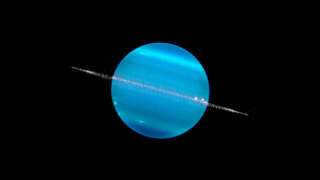
The planet Uranus, the seventh celestial body in our solar system, was recently discovered and has been minimally studied. Prior to its official discovery by William Herschel, people had observed this planet but mistakenly identified it as a star. As a result, Uranus remains a significant enigma for humanity. It is commonly referred to as “Huge Uranus” due to its status as the third largest planet in our system. Its equatorial diameter is four times larger than that of Earth, and it has a mass that is 14 times greater. Despite its size, Uranus is the lightest among the gas giants because it is predominantly composed of ice, specifically ammonia, methane, and water. The presence of methane in its atmosphere gives Uranus a blue appearance when viewed from Earth. Consequently, Uranus is classified as a gaseous giant planet.
In contrast to other planets, Uranus rotates on its side, with an axial inclination of over 98°.
Discovery History
The English scientist John Flemsteed first recorded the planet in 1690. He observed it multiple times but only noted it as star 34 in the Taurus constellation. In the 18th century, the French astronomer Le Monier studied the planet for nearly 20 years, still mistaking it for a star.
Initially, William Herschel believed Uranus to be a comet. In 1781, while observing the Taurus constellation, he noticed a celestial body where astronomical maps indicated emptiness. The object moved slowly compared to nearby stars and was clearly visible.
Uranus was the first planet discovered using a telescope. A model of this telescope can be found in the Bath Museum in the UK.
When Herschel studied the celestial body that had been discovered, he observed that its size changed as it approached, leading him to conclude that it was not a star. However, he did not find the characteristic tail or head of a comet. Interestingly, while comets remained clear in the telescope lens, this new object appeared blurred. Nevertheless, Herschel was able to determine that the object followed an elliptical and highly elongated orbit.
Meanwhile, the Russian astronomer A. I. Leksel calculated the distance between the Earth and the celestial body, which turned out to be more than 18 times the distance from the Sun to our planet. No other comet had been observed at such a vast distance before. The German scientist Bode suggested that the object should be classified as a planet, a suggestion that was eventually confirmed by Herschel himself in 1783. This groundbreaking discovery earned Herschel a lifelong stipend of 200 thousand pounds and an invitation to relocate to Windsor Palace. The King of England was eager to personally observe the stars through the scientist’s telescopes.
Unlike the other planets in our solar system, Uranus has a unique distinction in that its name is derived from Greek mythology instead of Roman mythology.

Planet’s Characteristics
The planet Uranus possesses the following traits:
- Mass – 8.69×1025 kg
- Uranus has the second lowest density
- Equatorial diameter – 51118 km
- Polar diameter – 49946 km
- Uranus orbits at a velocity of 6.8 km/sec
- The acceleration due to gravity is approximately 9 m/sec 2
- The orbit is inclined at an angle of i=0.773° to the ecliptic
- There are 27 satellites
- Rings have been detected
Motion
First and foremost, Uranus is known for its unique movement around the Sun, which scientists refer to as “retrograde”. Unlike other planets that follow a wavelike orbit, Uranus rolls like a bowling ball, resulting in a completely different pattern of seasons and day-night transitions. On Uranus, the concept of time, as understood by Earthlings, only changes at the equator. The sun appears very low, similar to Earth’s circumpolar latitudes. This change occurs approximately every 17 hours and 50 minutes in Earth time.
At the poles of Uranus, day and night shift occurs once every 42 years. Scientists believe that this tilt of the axis and the corresponding time change is the result of a collision with a celestial object billions of years ago, during the planet’s formation.
Uranus has a year that lasts 84.5 Earth years, and it is still a mystery why the polar regions are colder than the equator despite receiving more sunlight. Scientists have yet to find an explanation for this phenomenon.
Structure and Atmosphere
Researchers have determined the structure of Uranus and its atmosphere through spectrographic observations and photographs taken by probes. It is confirmed that there is no metallic hydrogen in Uranus’s interior, which is primarily composed of rocks and methane and ammonia ice. The atmosphere consists mainly of helium and hydrogen, while the planet is surrounded by multiple layers of clouds made up of different gases, molecular hydrogen, and ice.
The composition of Uranus consists of three distinct layers: a solid inner core, an icy mantle, and a gaseous outer shell primarily composed of helium and hydrogen. Methane, accounting for approximately 3% of the planet’s composition, is responsible for its striking blue hue. Additionally, the upper layers contain hydrogen oxide and hydrogen dioxide.
It is important to note that the model described above is purely speculative, as there are alternative models that dispute the existence of a solid rocky core on Uranus. Currently, scientists have not been able to provide a definitive understanding of the planet’s structure. The accurate determination of the planet’s composition, geophysics, and geology will significantly contribute to our understanding. However, such investigations are not scheduled to take place until the 2020s or 2030s. It is anticipated that these future studies will allow for the collection of chemical samples from various atmospheric layers for the first time.
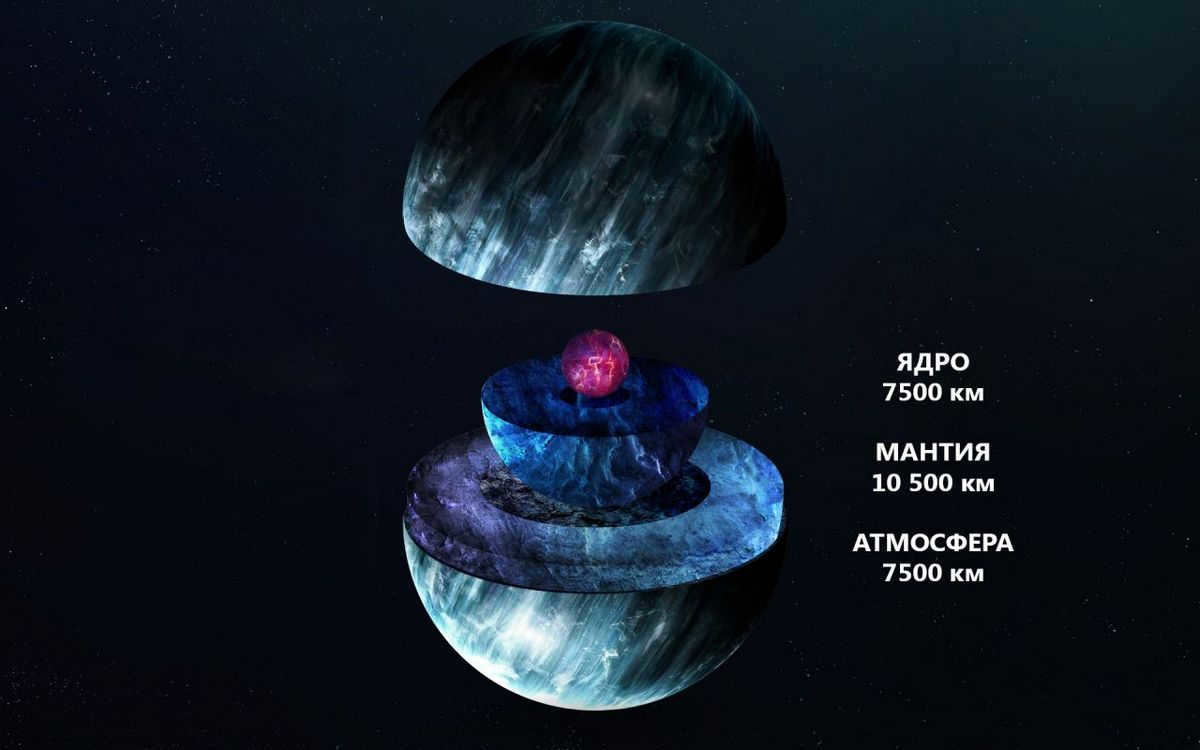
Moons
Uranus has a multitude of moons. While several of them were once captured by Uranus’s gravitational force and subsequently disintegrated. The largest moon is called Titania, followed by the smaller moon Oberon. Both moons were initially spotted by Herschel. Other notable moons include Umbriel, Ariel, and Miranda. Out of these, only Miranda is composed entirely of ice, while the others are a mixture of ice and rock. Some of these moons orbit within the planet’s rings, earning them the designation of inner moons.
All of Uranus’s moons are named after characters from the plays of William Shakespeare. This naming convention is also a tribute to the English discoverer.
Uranus Rings
While not as dazzling as the rings of Saturn, Uranus also boasts its own set of rings. These rings, like those found around other gas planets, are composed of small, dim particles measuring no more than a meter in diameter. Although not as widely known, Uranus’ rings were actually the second set of rings to be discovered, following the discovery of Saturn’s rings.
Even though Herschel himself claimed to have observed them, his claims were not believed at the time due to the limitations of the telescopes available. It wasn’t until the 1980s that American astronomers confirmed his accuracy. By chance, while conducting observations of Uranus’ atmosphere, they spotted these rings using an onboard observatory. As of now, the presence of 13 rings has been confirmed. These rings are much younger than the planet itself and are believed to have formed after its formation. Some theories suggest that they are remnants of captured satellites. The brightest among them is the epsilon ring, which can even be seen from Earth using a basic amateur telescope.
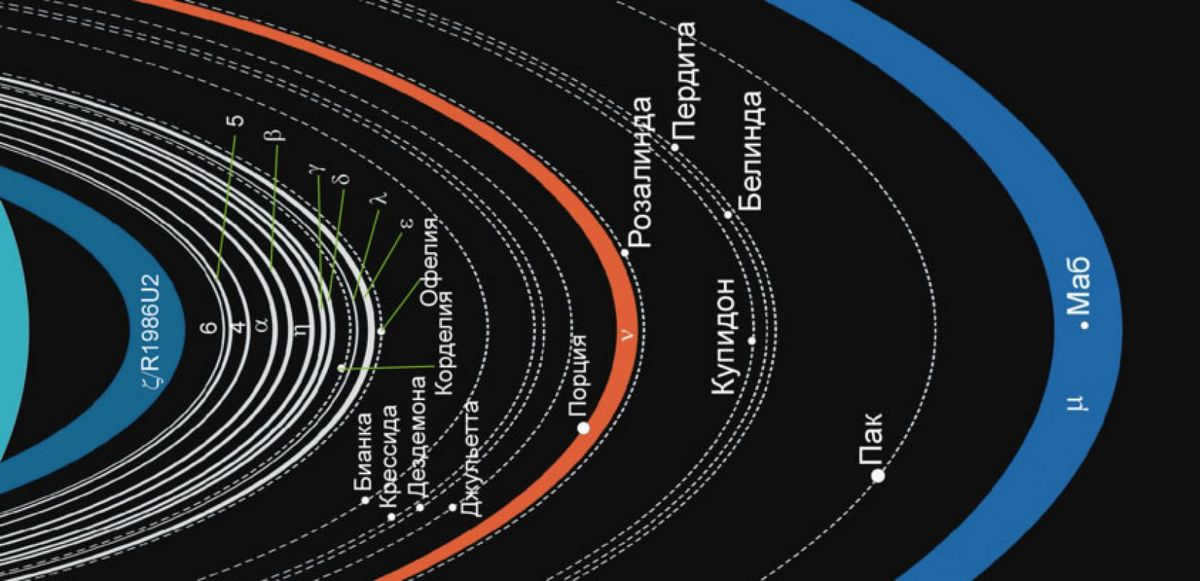
Exploration
Following the discovery of Uranus, its exploration posed a significant challenge due to its vast distance. Scientists were only able to observe the planet’s largest moons, speculate about its rings and atmosphere.
It wasn’t until the twentieth century that the Voyager-2 probe was launched in 1977 and successfully reached Uranus in 1986. The probe transmitted the initial images of a dim and barely visible surface obscured by clouds. The primary objectives of the Voyager 2 mission were to study the planet’s magnetic field, observe its atmosphere, analyze weather patterns, discover two previously unknown rings, and capture images of its largest moons. However, a portion of the planet remained out of sight as the probe approached the sunlit side of Uranus.
During the 1990s, the Hubble radio telescope made significant observations that provided valuable information. It was the first to document the atmospheric vortices on Uranus, uncover the existence of the “dark spot” within its clouds, and reveal the planet’s structural asymmetry.
These groundbreaking discoveries paved the way for a new project involving a team of 168 scientists. Presently, NASA is in the process of preparing the Uranus Pathfinder spacecraft for its upcoming launch. The spacecraft will embark on its journey from Earth and ultimately reach Uranus, where it will navigate through the planet’s atmosphere and collect numerous samples. This ambitious endeavor aims to conduct a comprehensive study of the outer regions of our solar system, with a particular focus on the vast expanses beyond Uranus. The anticipated launch of the spacecraft is planned for the 2020s, and the mission itself is expected to span approximately 15 years, with nearly a decade dedicated to the voyage towards the enigmatic blue planet.
Did you know?
- Did you know that Uranus is made up of 80% various liquids, including water in the form of superfrozen ice?
- It’s interesting to note that Uranus can actually be seen with the naked eye from Earth, as long as you know its exact coordinates and stay away from light pollution in the city.
- Here’s a fascinating fact: the magnetic field of Uranus is ten times stronger in the northern hemisphere compared to the southern hemisphere.
- One of the most amazing things about Uranus is the massive storms that can cover vast areas, similar in size to continents on Earth.
- Another intriguing fact is that Uranus is the only planet in our solar system that gives off less heat than it receives from the Sun. Scientists are still trying to understand this phenomenon.
- Lastly, did you know that the largest satellite of Uranus, Titania, is only half the diameter of the Moon?
- Unlike other planets, Uranus and Venus rotate in opposite directions – from east to west on its axis.
- It takes three hours for the Sun’s light to reach the surface of Uranus.
- Uranus is the least studied planet in our solar system.
- Uranus has been featured in various cultural works, including satirical pamphlets written just three years after its discovery. It has also been included in novels by renowned science fiction writers and serves as the setting for the movie “Journey to the Seventh Planet” and the TV series “Space Patrol” and “Doctor Who.” Uranus continues to inspire fantastic comics, colorful anime, and popular computer games.
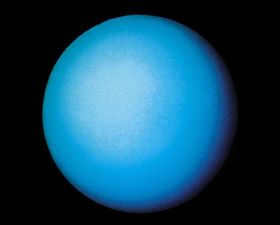
Optics advancements in modern times resulted in the expansion of the solar system’s boundaries on March 13, 1781, with the detection of Uranus, a planet that was discovered by William Herschel.
With a total of 27 satellites and 13 rings, it is the seventh planet in our solar system (as of 2013).
Understanding the Inner Structure
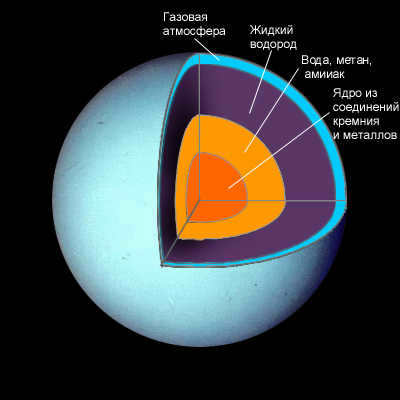
The internal structure of Uranus can only be determined indirectly. Scientists have determined that the planet has a mass of 14.5 times that of Earth by studying its gravitational influence on satellites. There is a hypothesis that Uranus has a rocky core primarily made up of silicon oxides, which would be about 1.5 times the diameter of Earth’s core. Surrounding the core, there would be a layer of ice and rocks, followed by a vast ocean of liquid hydrogen. However, another theory suggests that Uranus does not have a core at all and is instead a massive sphere of ice and liquid surrounded by a gas envelope.
Atmosphere and Earth’s Surface
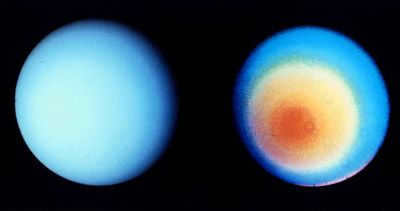
The primary components of Uranus’ atmosphere are hydrogen, methane, and water. These elements make up the majority of the planet’s interior as well. Unlike Jupiter or Saturn, Uranus has a higher density of around 1.58 g/cm3. This indicates the possibility of helium being present or a core made up of heavier elements. Methane and hydrocarbons can be found in Uranus’ atmosphere, while its clouds consist of solid ice and ammonia.
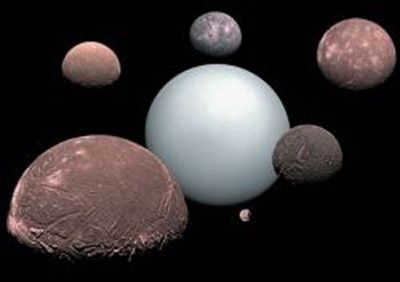
Similar to Jupiter and Saturn, Uranus also has a unique ring system. The rings of Uranus were serendipitously discovered in 1977 during a routine observation of an eclipse near the planet. Due to their low reflectivity, the existence of these rings had remained unknown until that time. Subsequently, the Voyager-2 spacecraft provided further confirmation of the presence of a ring system around Uranus.
The planet’s moons were actually found much earlier, in 1787, by the same astronomer William Herschel who discovered the planet itself. The first two moons to be discovered were Titania and Oberon. These moons are the largest ones orbiting the planet and are primarily made up of greyish ice. In 1851, the British astronomer William Lassell found two more moons, Ariel and Umbriel. Then, almost a century later, in 1948, the astronomer Gerald Kuiper discovered the fifth moon of Uranus, Miranda. Later on, the Voyager-2 spacecraft would go on to discover an additional 13 moons of the planet. Recently, several more moons have been discovered, so now, as of 2013, a total of 27 moons of Uranus are known.
Fascinating information about the Earth
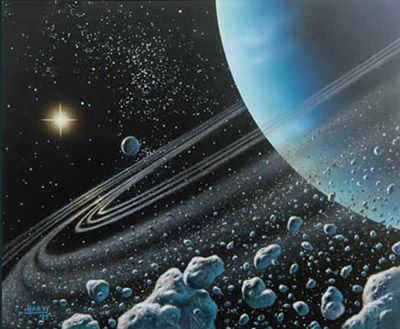
The discovery of a unique ring system on Uranus in 1977 set it apart from Saturn’s more well-known rings. Unlike Saturn’s bright rings, Uranus’ rings are composed of incredibly dark particles. These rings can only be observed when the light from the stars behind them is heavily diminished.
Uranus is also home to four large moons: Titania, Oberon, Ariel, and Umbriel. It is believed that these moons possess a crust, core, and mantle. Despite their significant size, Uranus’ moons are relatively small compared to other planetary systems. The farthest moon, Oberon, orbits at a distance of 226,000 km from the planet, while the closest moon, Miranda, orbits at a mere distance of 130,000 km.
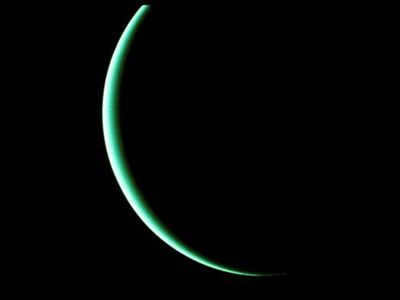
Uranus is unique among the planets in our solar system due to its axial tilt, which exceeds 90 degrees. This gives the appearance of the planet “lying on its side”. Scientists believe that this unusual tilt was caused by a collision with a massive asteroid, resulting in a shift in its poles. As a result, summer at the south pole lasts for 42 Earth years, with the sun never setting, while winter brings 42 years of uninterrupted darkness.
Not only is Uranus known for its extreme axial tilt, it is also the coldest planet in our solar system, with temperatures reaching as low as -224°C. The planet experiences constant winds, with speeds ranging from 140 to 580 kilometers per hour.
Exploring the world
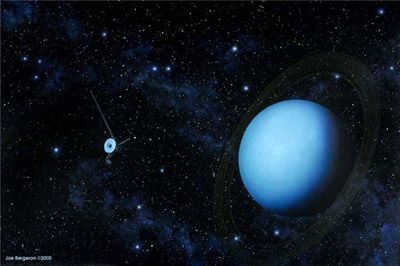
Voyager 2 is the only spacecraft that has successfully reached Uranus’s orbit. The information gathered from this mission was absolutely astonishing. It revealed that Uranus has a unique magnetic field composed of four poles – two major and two minor. In addition, temperature measurements taken at various points on the planet’s surface have left scientists puzzled. The temperature remains constant throughout the planet, with only a slight difference of about 3-4 degrees. The exact cause of this phenomenon is still unknown, but it is speculated to be related to the high concentration of water vapor in the atmosphere. This atmospheric moisture creates a pattern of air currents that is reminiscent of the oceanic currents found on Earth.
The enigmatic nature of Uranus makes it one of the most captivating celestial bodies in the solar system. Despite the wealth of data obtained from Voyager 2, the mysteries surrounding this planet remain largely unsolved. In fact, these discoveries have only deepened the veil of intrigue, leaving scientists with even more questions than answers.
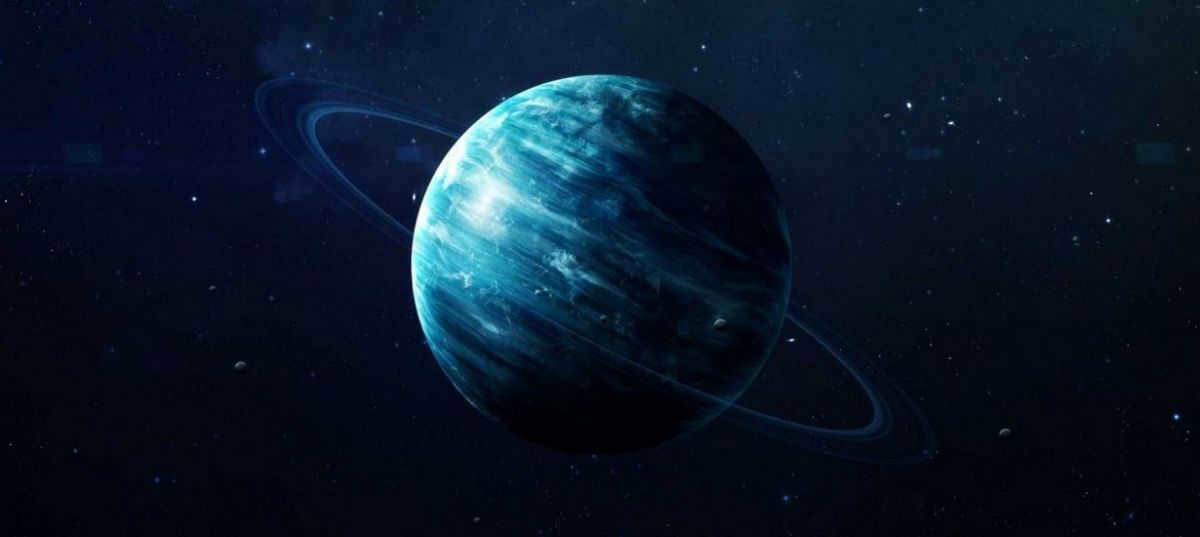
We are continuing our virtual exploration of the planets in our solar system. We started with Neptune, the last planet, and now we have reached Uranus, the seventh planet from the Sun. Uranus is located approximately 2.8 billion kilometers away from our star and is classified as a gas giant. While the term “gas giant” is typically used to describe Jupiter and Saturn, Uranus and Neptune are often referred to as ice giants due to their distance from the Sun. However, both terms are correct. Uranus is 14.6 times more massive than Earth and has a rotation period of 17 hours. Interestingly, the areas of the planet farthest from the equator have a rotation period of 14 hours. This unique rotation pattern of Uranus will be the focus of our discussion today.
Atmosphere
Similar to Neptune, Uranus obtains its vibrant blue-green hue from the abundant amount of methane present in its upper atmosphere. These two planets share many similarities, and their atmospheres are no exception. Hydrogen is the primary component of Uranus’ atmosphere, followed by helium and methane at higher altitudes.
Additionally, Uranus contains deposits of hydrogen sulfide, as mentioned in our previous article on the topic: “The Aromatic Essence of Uranus”.
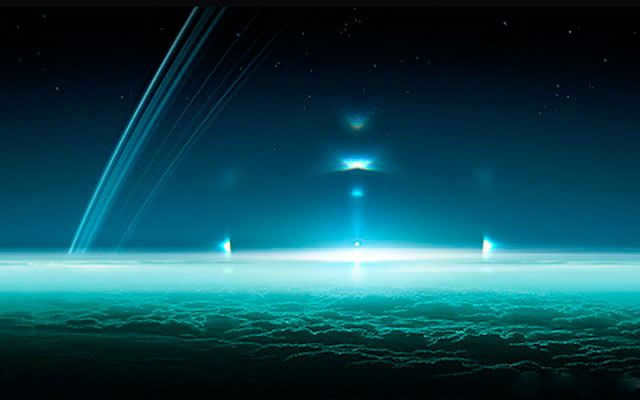
The center
The core of Uranus remains largely a mystery. Its existence has not been definitively confirmed by scientists. However, if it does indeed exist, it is believed to be composed of a combination of different metals and silicon.
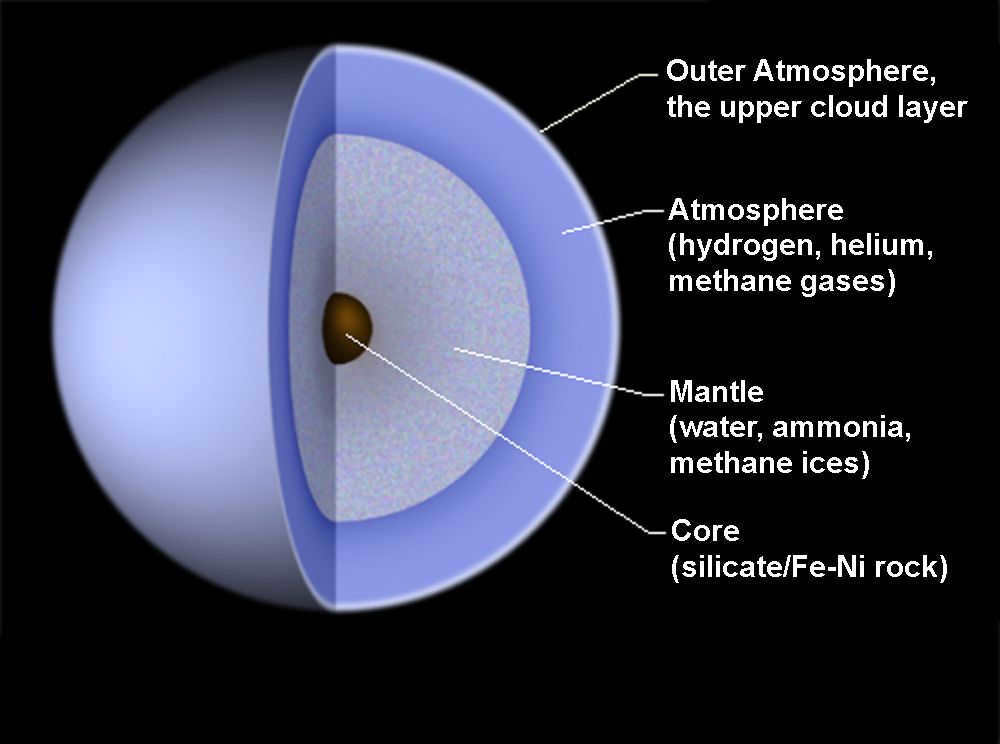
Rings
It might surprise you, but Uranus boasts a total of 13 rings. These rings are predominantly dark in color, making them quite difficult to detect. The discovery of these rings was made possible only because they obstructed the light from stars observed back in 1977.
Out of the 13 rings, eleven are primarily black in appearance, while the remaining two stand out due to their distinct characteristics. The outer ring, commonly depicted in images, features a vibrant blue hue, while the inner ring exhibits a striking red coloration. Moreover, the outer ring is also the widest among all the rings, making it more visible. Its width measures a staggering 96 km, while the other rings reach a maximum width of 10 km.
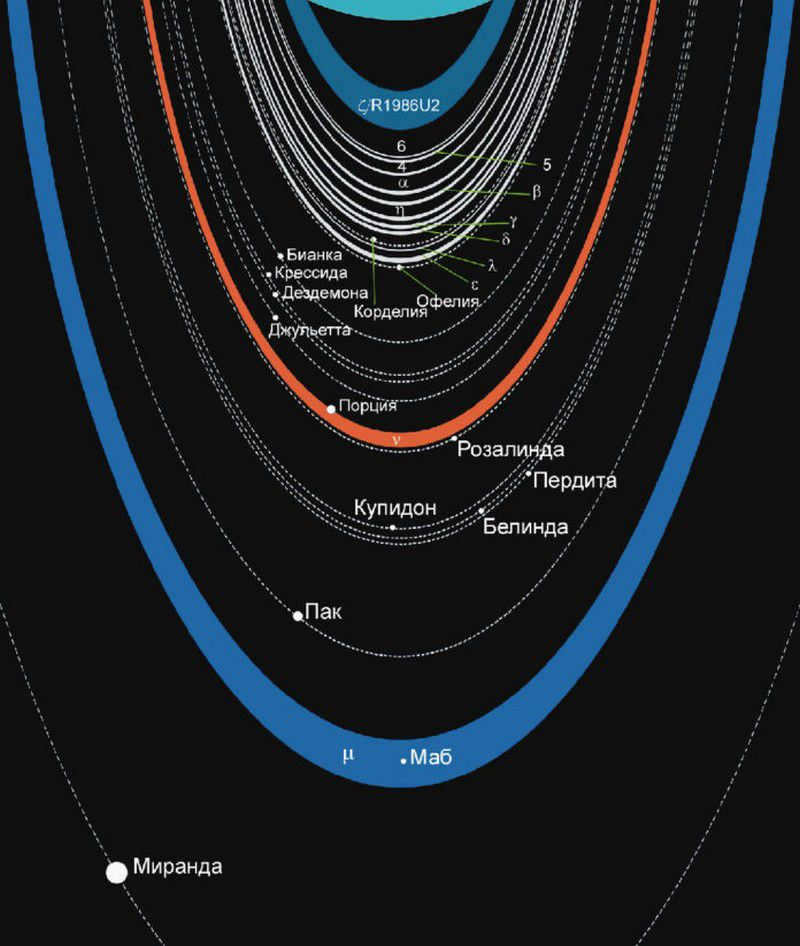
Satellites
Uranus possesses a total of 27 satellites, although the majority of them lack interest. The largest five are Miranda, Ariel, Umbriel, Titania, and Oberon. These satellites consist mainly of ice and rock. Contrary to popular belief, the ice on these satellites is composed of frozen ammonia, methane, and CO.2, not water. These satellites orbit the planet in a manner similar to our Moon, always presenting the same side.
Magnetosphere
The magnetic field of Uranus is not as straightforward due to its peculiar rotation. Unlike other planets, its magnetic axis does not align with its axis of rotation, causing a slight shift. In fact, the two axes are tilted at an angle of 60 degrees relative to each other. This unique arrangement results in Uranus having four magnetic poles, consisting of two major poles and two minor poles. The magnetosphere of Uranus also takes on a corkscrew shape due to the tilted magnetic axis. In contrast, the magnetospheres of other planets extend in a straight line in the face of the solar wind.
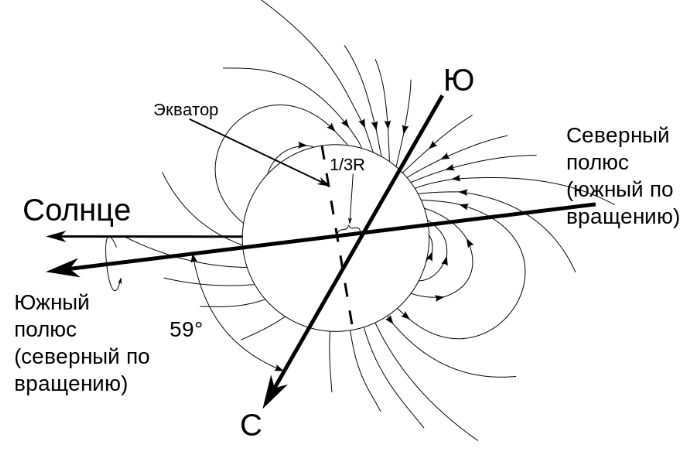
Temperature Differences
The temperature on Uranus is consistently frigid, comparable to Neptune with values reaching about -220 degrees Celsius. However, in the tropopause, a temperature as low as -224 degrees Celsius has been recorded, suggesting that Uranus is actually the coldest planet in the solar system, even colder than Neptune, which is located further from the Sun. Interestingly, in the stratosphere of Uranus, temperatures can rise up to a scorching +520 degrees.
Uranus itself emits very little thermal energy, about 2.6 times less than Neptune. Most of the energy that the planet receives from the Sun is retained internally. The reason for this phenomenon is still unknown, although it is possible that there is a layer in the upper regions of Uranus that traps heat.
Just a reminder, the planet is actually tilted on its side. Well, not exactly literally, since we’re talking about space where the idea of top and bottom isn’t really relevant. Uranus has a tilt of 98 degrees, so each part of it takes turns facing the sun.
What does this mean? It means that a more or less normal day and night cycle only happens at the equator, and even then, only during the equinox when the Sun is directly in front of it. At the poles, the time of day remains the same for 42 years. Initially, it’s daytime for four decades, and then it becomes nighttime for the same number of years.
Climate
If we compare the climate on Uranus to that of other gas giants in our solar system, we can see that it is relatively stable, with no sudden temperature fluctuations. The winds on Uranus blow in the opposite direction of the planet’s rotation and generally stay below speeds of 100 m/s, except at the equator where they can reach that speed. As you move closer to the poles, the winds calm down significantly.
It is difficult to determine exactly how the seasons change on Uranus as further research is still needed. However, based on the existing data, we can conclude that the thickness of the clouds and the overall structure of the planet do undergo changes during certain periods.
Mysteries
If you have made it this far, you most likely have already deduced that the primary enigma surrounding Uranus is the inquiry, “Why is the planet positioned on its side?”. The true explanation remains unknown, but there are certainly speculations. One theory proposes that in the distant past, during the formation of our solar system, Uranus collided with a protoplanet, causing it to tilt on its side, altering the magnetic axis and decreasing the heat flow. This hypothesis could potentially account for nearly all inquiries regarding Uranus, however, it is improbable that we will ever ascertain the actual truth.
The second significant enigma involves its moon Miranda. The images clearly reveal a region that is essentially untouched by meteorites. This distinctive pattern, measuring 140×200 km, is easily observable in the photograph. It has been dubbed “Chevron”, yet its origin remains a mystery.
